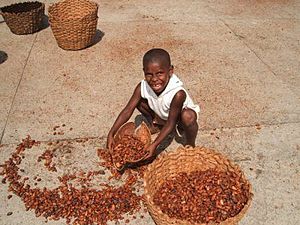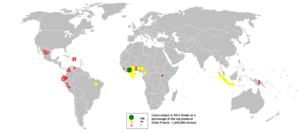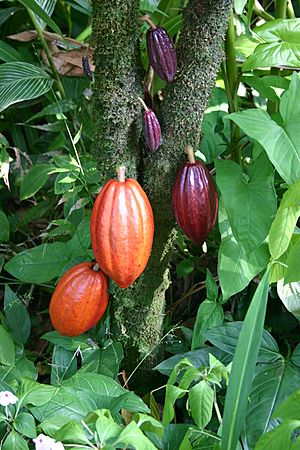Child labour in cocoa production facts for kids
Did you know that most of the world's chocolate starts as cocoa beans grown in West Africa? Countries like Ivory Coast and Ghana produce almost 60% of all cocoa each year. Sadly, many children in these areas are involved in dangerous work on cocoa farms.
A study in 2018-2019 found that about 1.48 million children in Ivory Coast and Ghana were doing hazardous tasks. This includes using sharp tools, handling farm chemicals, and carrying very heavy loads. This number represents 43% of all children living in farming families in cocoa-growing regions. Even though cocoa production has grown a lot, the number of children doing this risky work has also increased. Most of the focus on this issue is in West Africa, which supplies 69% of the world's cocoa.
Contents
Understanding Child Labor in Cocoa Farms
Child labor means work that is harmful to children. It can hurt them mentally, physically, or socially. It also stops them from going to school or makes them leave school too early. Not all work children do is child labor. For example, helping with light chores on a family farm for a short time, under supervision, and without missing school, is usually okay. This kind of work can help children learn skills for their future.
However, tasks like carrying heavy loads or using chemicals are considered dangerous child labor. Child trafficking, where children are tricked or forced into work, is a serious crime.
Why Children Work on Cocoa Farms
Many children work on cocoa farms because their families are very poor. Farmers earn very little money from cocoa beans, sometimes less than $2 a day. This is below the poverty line. To save money, families often rely on their children to help with farm work. Children aged 12 to 15 might do the same amount of work as adults but get paid less, or not at all.
Poverty in these rural areas means families often lack good schools, clean water, and healthcare. Sometimes, parents want to teach their children farming skills, and using them for labor helps reduce costs on the family farm.
Reports on Child Labor in Cocoa
In 2001, a report called A Taste of Slavery won an award for showing how children were forced to work on cocoa farms. It said that some children were promised good jobs and schooling but were instead made to work long hours, up to 100 hours a week. They were also beaten if they didn't work fast enough or tried to escape.
Later studies continued to show the problem. A 2015 report found that about 1.4 million children aged 5 to 11 were working in cocoa-growing areas. Around 800,000 of them were doing dangerous jobs like using sharp tools or carrying heavy loads.
In 2016, Fortune magazine reported that about 2.1 million children in West Africa were still doing dangerous and tiring work harvesting cocoa. The report explained that cocoa farmers earn very little, often less than $1 a day, which is far below the extreme poverty line. This makes it very hard for them to improve their lives.
Efforts to Reduce Child Labor
Many groups are working to stop child labor in cocoa. The U.S. Department of Labor works with the governments of Ghana and Ivory Coast to address the issue. The International Cocoa Initiative (ICI), which includes major chocolate companies, has set up a system to monitor farms for child labor.
In 2018, a pilot program by Nestlé and the ICI found a 51% decrease in children doing hazardous jobs on farms. Another study in 2019 showed that dangerous child labor was reduced by one-third in communities where company programs were active.
However, progress has been slow. A 2018 report, the Cocoa Barometer, stated that no company or government was close to reaching the goal of ending child labor or even reducing it by 70% by 2020. Poverty, lack of schools, and growing demand for cocoa make it a big challenge.
Child Trafficking and Forced Labor
Sometimes, children are tricked or forced into working on cocoa farms. A 2000 documentary by the BBC showed how children were trafficked into forced labor in Ivory Coast. The United States Department of State estimated that in 2001, about 15,000 children were forced to work on farms in Ivory Coast, including cocoa farms.
Many of these children come from poorer neighboring countries like Mali and Burkina Faso. They might be from poor families or slums and are sold for a small amount of money. Their parents are told the children will find work and send money home, but the children often end up working in conditions where they are not paid and cannot leave. Some children begging for food are even lured from bus stations and sold.
By 2020, Ghana and Ivory Coast had made some progress in fighting child labor abuses in the cocoa sector. In 2012, Ferrero, a chocolate company, promised to end forced child labor in its supply chain by 2020.
Legal Actions Against Companies
Some groups have tried to take legal action against chocolate companies in the U.S. In 2015, lawsuits claimed that companies like Mars, Nestlé, and Hershey's did not tell consumers that their products might involve forced child labor. These lawsuits were dismissed, but appeals were filed.
Nestlé has stated that it has built or renovated schools in cocoa-growing areas and helps families afford to keep their children in school. They also have a system to identify children at risk and report any cases of child trafficking to authorities.
Cocoa Production and Where it Goes
Cocoa farming started in Ghana in the late 1800s and in Ivory Coast in the early 1900s. Ghana was the biggest producer in 1910, but Ivory Coast took over by 1980. Most cocoa farms in both countries are small and family-owned. Family members, including children, are often expected to help.
In 2018-2019, the world produced about 4.78 million tonnes of cocoa beans. African countries produced 69% of this. Ivory Coast and Ghana alone produced more than half of the world's cocoa.
The Netherlands imports the most cocoa beans by value, as it's a major entry point into Europe. The U.S. imports the most cocoa powder. The UK buys the most retail chocolate and has one of the highest chocolate consumption rates per person.
How Cocoa is Harvested and Processed
Cocoa trees are delicate and need pesticides and fungicides. Cocoa pods don't all ripen at once, so they are harvested many times throughout the year. Ripe pods are cut from the tree using a curved knife on a long pole. The pods are then opened, and the wet beans are removed. These wet beans are taken to a facility to be fermented and dried.
Many of these tasks can be dangerous for children:
- Using Chemicals: Mixing and applying chemicals can be risky because of pesticide exposure, especially since protective clothing is often not worn.
- Sharp Tools: Clearing plants and harvesting pods often involves using machetes, which can cause cuts. While older teens (15-17) might learn this skill, it's very risky for younger children. Many children have cuts on their legs from these tools.
- Heavy Loads: Transporting wet beans can be dangerous due to long distances and heavy loads, which can cause injuries.
The International Cocoa Initiative works to protect children's rights and stop child labor. They say that light, non-hazardous tasks done by children on family farms, under supervision, and without missing school, are acceptable. But activities like carrying heavy loads or using chemicals are considered "unacceptable forms of child labor" because they are physically dangerous.
Working Towards Solutions
Fair Trade Chocolate
Some chocolate makers have started "fair trade" programs. These programs aim to give cocoa farmers a better price for their cocoa. Traditionally, farmers in developing countries received very low prices, leading to poverty. Fair trade tries to create a system where farmers get enough money for food, clothes, and school fees for their children.
However, some people question how effective fair trade is. A 2014 article in The Economist suggested that workers on fair trade farms might sometimes have a lower standard of living than those on other farms.
Importance of Education
Research in 2019 by the International Cocoa Initiative found that better education leads to less child labor. In communities with the best schools, child labor was 66% lower than in communities with the lowest quality of education. This shows how important schooling is for children's safety and future.
The Harkin–Engel Protocol
In 2001, some U.S. lawmakers tried to create a "no child slavery" label for chocolate. Instead, chocolate companies and lawmakers agreed to the Harkin–Engel Protocol. This was a voluntary agreement to remove forced child labor from the cocoa industry. The goal was to achieve this by July 2005.
As part of this agreement, the International Cocoa Initiative was created. Its goal is to improve the lives of children in cocoa-growing communities and help end child labor.
Challenges and Progress
The original 2005 deadline for the Harkin–Engel Protocol was not met. It was extended multiple times, with new goals for reducing child labor. By 2015, the goal to reduce child labor by 70% by 2020 had not been reached.
However, there has been some progress. The World Cocoa Foundation reported in 2020 that dangerous child labor had been reduced by one-third in communities with company programs. Also, government efforts in Ghana mean almost all children now attend school, and four out of five do in Ivory Coast. Even with a big increase in cocoa production over the last 10 years, child labor has not surged at the same rate.
A 2022 report, the Chocolate Scorecard, found that several major chocolate companies are "leading the industry" in addressing child labor, and many others are starting to put good policies in place.
Cocoa in Media and Exhibitions
The issue of child labor in cocoa has been featured in various media:
- Documentaries:
- The Dark Side of Chocolate (2010)
- Slavery: A Global Investigation (2000)
- Books:
- The Bitter Side of Sweet by Vivian Yenika-Agbaw (2016)
- Chocolate Nations by Orla Ryan (2011)
- Exhibitions:
- Bitter Chocolate Stories at the Tropenmuseum Amsterdam (2018–2019)
Images for kids
See also
 In Spanish: Trabajo infantil en la producción de cacao para niños
In Spanish: Trabajo infantil en la producción de cacao para niños





